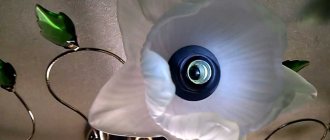What is grounding and why is it needed?
According to clause 1.7.28 of the Electrical Installation Rules (PUE)
,
grounding
is an intentional electrical connection of any point in the network, electrical installation or equipment with a grounding device.
Grounding is divided into protective
- performed for electrical safety purposes, and
working
(functional) - performed to ensure the operation of the electrical installation. Most of us rarely encounter working grounding. It is used in power supply networks - at power plants, transformer substations, etc. But we see protective grounding everywhere. This includes the third contact in modern “European” style sockets, and the same third wire when connecting LED lamps. It turns out that phase and zero are sufficient to illuminate the device, but in order to remain safe, a grounding conductor is also needed.
What else to consider when choosing a chandelier
An ideal chandelier must meet the following requirements:
- made of high-quality and reliable materials;
- has low weight;
- economical to operate;
- provides powerful lighting;
- matches the style and functionality of the room.
A few more tips:
- Before choosing a chandelier, you need to clearly determine in which room it will be installed and what level of lighting it should provide.
- You should pay attention to the size of the sockets, because choosing light bulbs for non-standard options is very difficult. The most common socket sizes are E27 ("normal" lamp) and E14 (minion).
- If the interior has a lot of textures and details, it is better to choose a chandelier in warm colors.
- Buyers often have to choose between a round or long chandelier. It should be borne in mind that long models evenly distribute light over their entire area, so they are often mounted above the dining table or in a small hallway. Round chandeliers softly diffuse light and can be installed in a bedroom or living room.
Connecting a halogen chandelier with or without remote control
Halogen lamps operate on low voltage, so direct connection to a 220V network will damage the device. Such lamps are equipped with special equipment. Transformers and power supplies are included with the device. When purchasing, you should check that all spare parts for the lamp are available so that you don’t have to solve additional problems later.
A halogen chandelier equipped with a remote control has a control unit that is mounted inside the lamp. There are 3 cables coming from it. 1 of them is an antenna; it cannot be connected to electrical networks. And the other 2 serve to supply current. They need to be securely attached to the electrical cables through the terminal block. Phases are to the 1st terminal, and zero is to the 2nd. If there is a ground connection, connect it to the 3rd terminal.
Power and type of lamps for chandeliers
- Incandescent lamps produce light that is inexpensive and easy on the eyes. But they are not cheap and sell out quickly. Also, these lamps are not suitable for use with fabric or paper lampshades.
- Energy-saving lamps - characterized by economical energy consumption and long service life. The disadvantage is the presence of mercury vapor inside the lamp, which if damaged will have unpleasant consequences.
- Halogen lamps provide bright light and have a long service life.
- Fluorescent lamps are a bright, cool light source that are energy efficient and have a long lifespan. Another benefit is their remarkable light output, making them ideal for public spaces.
- LED is the most profitable to date. They are inexpensive, safe to use and last up to 3 years. The lamps are not afraid of voltage surges, do not flicker and do not overheat.
The power of the chandelier should correspond to the sum of the powers of all lamps or even have a small margin. This indicator is selected taking into account the purpose for which the room will be used. Typical values are shown below:
- for the bathroom you need a chandelier with a power of 80-100 W;
- for the kitchen - 120-150 W;
- for the living room - 200-300 W.
It is important to know. Using a lamp with a power higher than that specified by the chandelier manufacturer can lead to unpleasant consequences: destruction of the socket, damage and deformation of the chandelier.
If the room area is more than 20 square meters, then experts recommend using different lighting fixtures. Suitable wall lamps, floor lamps, table lamps.
Rules for connecting wires
There are no small details when working with electricity. Therefore, we connect the wires in the chandelier according to all the rules. When combined into one group, it is not enough to simply twist them and screw on the protective cap.
You need to connect the wires from the chandelier and the switch in the terminal box
Such twist will sooner or later oxidize and begin to heat up. It is highly advisable to solder such connections. If you know how to handle a soldering iron and tin, definitely do this. This will guarantee normal contact and the connection will not heat up.
Now let's talk about how to connect the wires from the chandelier with the wires from the switch (which are on the ceiling). According to the latest rules, twists are not allowed. Terminal boxes must be used. Most modern chandeliers are equipped with them. If not, buy it at any hardware store or retailer of lighting fixtures.
When using such a terminal box, a problem arises: a twist of a large number of wires simply does not fit into the hole. Output: solder a conductor to the connection (copper, single-core or stranded, with a cross-section of at least 0.5 mm 2 ). This connection is well insulated, and the free end of the soldered conductor is inserted into the terminal box (a long one is not needed - 10 cm is more than enough).
Having inserted all the wires from the chandelier into the terminal block and tightened the screws, the entire structure is raised to the ceiling. There it is pre-fixed, after which the wires are connected to the terminal block in the required order. In this case, it is important to set “zeros” one opposite the other. Phases are connected to phases in random order.
How the wires on the chandelier are separated, how the conductor and the chandelier are connected to the terminal block - all this is in the video.
How to choose the right chandelier for a room
Considering the variety of shapes, types, colors of ceiling lampshades and their intended use as an indispensable element of the interior, it is easy to get confused in the choice. We offer brief tips and rules for choosing an electric lamp for a room.
- Observe the external dimensions of the chandelier and the overall dimensions of the room. Under the high ceiling of a large living room, a small single-ceiling chandelier will seem illogical. Just like in a small room with a small window and a low ceiling, it will not be appropriate to hang a luxurious multi-tiered royal chandelier. In other words, look for the “golden mean” to achieve harmony in the space.
Huge industrial style chandelier
- Color combination. The color of the shades should complement the overall background decor of the room. Contrasts are undesirable here, as this irritates the human psyche, which will certainly affect communication with loved ones. As a result, you will definitely want to change the provocative chandelier. The most tolerable and harmless shade of shade is white or transparent. For this reason, lamps made of crystal, white glass and plastic are too often chosen.
Luxurious chandelier with colored glass lampshades
- It is very important to guess the appropriate diameter of the lamp for the overall dimensions of the ceiling plane. Here you can use mathematics: divide the length and width of the room’s ceiling (in cm) by 30, add up the resulting numbers and multiply the resulting sum by 2.5 - this is the approximate diameter of the chandelier for this ceiling.
Well-chosen diameter of the chandelier that serves as zoning for the kitchen dining area
- The height of the lampshade suspension is another nuance of the right choice. No one wants to hit their head on the edge of a crystal or any other chandelier. Therefore: from the floor to the edge of the ceiling there must be at least 2 meters in height. As mentioned earlier in the text, most modern models of pendant chandeliers have a height adjuster and therefore there are no problems with this problem.
Laconic pattern on a long pendant
- It is worth taking seriously the purpose of the room in which you plan to purchase a lamp. For an office, nursery or kitchen, intense light is very important and necessary, for example, we choose open-type lampshades or modern-style models with halogen or fluorescent lamps. But for a bedroom or living room, a soft light flux that does not irritate the eyes is desirable, suitable for rest and relaxation. For these purposes, it is better to choose closed shades and classic “Ilyich bulbs”.
Chandelier with fabric lampshade in a colorful interior in eclectic style
- And the last rule for choosing a chandelier is your taste. You live in an apartment and see how this light works every day. This means that you must evaluate the shape, size and color of the electric lamp and only then meet all the selection criteria described above.
Cloud chandelier against the background of gray living room walls
Of course, the harmonious combination of the chandelier with the interior style plays an important role. So, for a vintage interior style or for a Provence style, a rustic ceiling is not at all suitable. Choose classic crystal, airy shapes or multi-tiered pendants for these styles.
In the same way, if the interior is in the Art Nouveau, high-tech, military, futurist and other neo-modern styles, it will be “decorated” with an old-fashioned lampshade and made of simple material. If the design is modern, the lamp should correspond to the fashion of the 21st century.
For a large living room, a pair of identical pendant lamps is a fairly frequently used technique that allows you to illuminate a large area and create an original interior.
There can be three chandeliers if they fit harmoniously into the design of the room
In modern interiors, one chandelier is sometimes replaced by many light bulbs suspended on cables without shades
If you carefully consider all the above tips, it is not difficult to find a chandelier that is ideal in appearance, shape and color, which will delight the eye for many years!
Connection options
Grounding device
First option. If street lighting and luminaires are installed in networks that have an insulated neutral, grounding of metal structural elements (reinforcement of supports with a hook, pins, etc.) occurs using special grounding devices. They consist of the grounding conductor itself, as well as grounding conductors.
Grounding electrodes are special elements made of metal. They are placed in the ground. Grounding conductors can be in the form of vertical rods or horizontal steel strips. When installing vertical grounding conductors, they should be placed in the ground to a significant depth (up to 3 meters). As a result of installation, the upper part of this rod should be located at a distance of 0.5 meters from the soil plane. The same depth is used when installing horizontal steel strips. Such ground electrodes are often used in rocky soils. But grounding conductors are used to connect grounding conductors. They must have a minimum diameter of 6 mm. Grounding conductors and grounding conductors are connected to each other by welding. The place of such a connection must be painted. Second option. There are situations when outdoor lighting and luminaires need to be installed in networks with a grounded neutral. Then all metal structural elements (pins, hooks, fittings, etc.) should be grounded by connecting them to the neutral working wire. This lamp connection is usually carried out using a special bolt, which is welded to the support.
Grounded lamp on a pole
Grounding for lamps placed on metal supports to create street lighting with cable power is carried out using the following methods:
- in networks where there is an insulated neutral, a metal sheath should be used for the cable. The connection here occurs to the grounding screw on the luminaire body through a protective conductor;
- in networks where there is a grounded neutral, a neutral conductor is used. It is connected to the cable sheath. The luminaire body is connected through a special grounded screw and a PE conductor.
These methods are suitable for connecting all types of lamps. After all electrical installation work has been carried out, it is imperative to measure the resistance of the installed grounding device. To do this you need to use a special device. According to its indicators, the resistance should not be higher than 50 Ohms. Compliance with resistance indicators is especially important for open areas that are located away from buildings. This is due to the fact that such outdoor lighting poles very often become the site of lightning strikes. And here, without grounding, overvoltage may occur throughout the entire network. And this, in turn, can lead to various serious consequences.
Choosing a chandelier for rooms
The best chandelier depends largely on the room. Initially, you need to clearly and clearly understand where you are buying the lamp: in the living room, bedroom, children's room or kitchen. The shape, color, and style of the chandelier depend on this. An incorrect combination of design elements can spoil the overall impression of the interior, but a competent approach will favorably emphasize all its advantages.
Young people are more likely to choose modern styles, including neoclassicism, while older generations are more conservative in this regard.
To the living room
Often it is the chandelier that serves as the center of attraction for views from the entire abundance of the room’s interior. After all, it has long been accepted that the room where guests are should always have the best. But even with the best you have to be careful. After all, you can take a stylish and chic lamp that does not fit into the interior, which will completely ruin the impression of the room.
There are several popular models this year. One option is translucent glass lampshades with a metal frame. This “mixture” is somewhat similar to sketching chemical compounds in a notebook. This option can also be suitable for the kitchen.
Since glass shades have become the standard of the past for almost everyone, they can be removed without compromising the design. Thanks to this approach, you will end up with something like a craft made from branches.
On a note!
To turn a chandelier into an interesting design move, choose several rarely used lamps, for example, in retro style.
There is a whole design direction - lighting design, which uses additional lighting elements in combination with the main one. One such way to easily illuminate corners involves installing a wall light (from the French for “hand”). These lamps are simply placed in the corners or anywhere on the wall, coordinating the design with the central chandelier.
If the main source of light in the living room is a full-size chandelier, a wall sconce is a great option. It is worth remembering that this style is not suitable for all rooms.
The industry offers many more options, for example, figured chandeliers in the form of medieval lamps.
For the bedroom
They come closely to the choice of lighting for the bedroom, because comfort and the opportunity to relax in the “intimate territory” depend on it. This is probably why design professionals prefer classics to bold chandeliers in modern high-tech and loft styles.
On a note!
To create decorations in the bedroom that resemble drawings from an old children's book with fairy tales, it would be appropriate to use pastel colors, a slight shine of metal, and beautiful curves of lighting elements.
For antique decor in the bedroom, patterns that resemble patterns from an old tattered adventure book are suitable. Light jewelry incisions on metal, delicate and graceful interweaving of street lamps in combination with light colors are an ideal design option.
Undoubtedly, although such variations are immortal classics that can fit into any interior, not everyone will like them. Therefore, no one bothers to use the same round lampshades, “toothpick” compositions and, in general, any chandelier in a modern style. The main thing is not to overdo it.
Don't be afraid of modern solutions. Recently, lamps in the Art Nouveau style have become a popular lighting option. The main feature of this direction is symmetrical shades or, conversely, asymmetrical aerodynamics. Modernism is also used in a classic interior as a complement, because there are countless variations of this style.
For the hall
The hallway is a place with the widest possible furnishing options. Here you should pay attention to the variations of chandeliers that will fit very well into the interior of the guest bedroom:
- Spotlights for suspended ceilings. This is the kind of lighting that many people are already tired of, especially with standard placement in multi-level ceilings. But this approach is still alive, because many apartments have low ceilings, and installing a large chandelier will make normal movement inconvenient. The choice of lampshades for lamps is large; you can create extravagant shimmers of light and other effects.
- Drops, icicles, gemstone looks and many other stylized accents can make a room more beautiful than anything you know. By the way, previously such solutions were used exclusively for stretch and stretch ceilings, but not so long ago overhead options appeared.
- Ceiling lamps or, as they are also called, “flying saucers”. A simple, but no less interesting option with a stretch ceiling that will be easy to care for. The key feature of these chandeliers is practicality; they will not disturb tall people, especially low ceilings. Although these lamps don't have the luxurious appearance of spotlights with lots of shades, there are actually a huge number of variations in their use. For an interior in a restrained classic style, you should think about choosing a round shape. For the “Scandinavian” style, the best option would be natural materials, as well as voluminous and soft shapes reminiscent of clouds.
- Chandeliers. Oddly enough, but classic life-size chandeliers are still preferred by the majority of local residents.
- High tech. Lighting in this style is a modern trend, creating an original but cozy atmosphere. Ceilings in “techno-lights” are made of various materials. But nickel-plated metal, multi-colored glass and bright plastic are often used. The advantages of these lamps are ease of maintenance and versatility. They are suitable for any room, regardless of its purpose and ceiling height.
Now simple materials are very popular, which are often used in an “aged” state:
- tree;
- specific;
- metal.
Lovers of the classics also do not ignore geometric shapes, because the use of various squares, triangles and arches allows you to turn a chandelier into a creation in no way inferior to the paintings of Picasso.
Hanging huge chandeliers, like those that once shone in palaces, is no longer in fashion. It is better to resort to the simplest solutions, take a closer look at the options that a few years ago could easily be used as garage lighting.
On a note!
The sophistication of the interior does not lie in the huge number of golden and shiny shades, various glass parodies of precious stones. The interior design must be appropriate - this is its key quality.
For kitchen
Due to some specific location of the light source in the kitchen, most likely, it may not be enough. Therefore, it is usually supplemented with track or built-in lamps, and the main light is placed above the dining area or island, where the main concentration of lighting is needed.
Professional designers advise not to limit your imagination and use various options:
- Install more than one main light fixture. For example, 2 or 3 short “twins”.
- With styles in the kitchen, everything is much simpler. Among the leaders are high-tech, loft and similar variations on this theme. You can safely hang metal lamps and any color will suit the products, from brass to copper, cast iron and steel.
- Complex curves and metal design ideas are not left out. Just because of the lack of shades in some options, the light may become too harsh and bright. Sometimes this kills all the comfort of the kitchen.
- However, in the kitchen some readings may not match. For example, intertwined patterns are losing their relevance. This does not mean that their use is strictly prohibited: for example, in a country style or in a kitchen with an exotic, African or tropical theme, they will be a good option.
For your information!
Enterprising designers have come up with an option to decorate light sources with the shapes of kitchen utensils. Starting from tin cans and ending with old, already dull and rusty carriages.
For the hallway
Most often, the entrance is one of the smallest rooms in the apartment. So here's what you need to try:
- in an elongated corridor, you should purchase a chandelier of the same elongated shape or symmetrically arrange two identical lighting fixtures;
- the optimal solution would be directional lighting fixtures that allow you to change the direction of lighting;
- It is better to choose products with a strict design.
For children's
Features of installing a hanging chandelier in a nursery:
- Models made of crystal and glass are unacceptable;
- designs with fabric and plastic lampshades are ideal;
- This type of lighting device is possible in the bedroom only if the area and height of the room allows it.
Bathroom
Lighting inside the bathroom has a practical and decorative function. With its help you can create an elegant and original bathroom decor.
In the photo, the author's model of the chandelier allows you to add a special personality to the bathroom interior.
How to ground a lamp
Results of the previous section:
- Luminaires of protection classes 0 and III do not use grounding;
- Protection class I luminaires must be connected to protective grounding
to prevent electric shock; - Luminaires of protection class II may use (rarely, and also not to ensure their own protection), or may not use (much more often) grounding.
Now that it is clear who to connect and who not, let’s take a closer look at connecting class I lamps to grounding. If the device is connected to the electrical network via a cable, then, as a rule, the wire or terminal for connection already has a grounding conductor or contact and it is enough to simply connect them to the corresponding conductors of the underwater cable.
Hermetic lead-in and grounding terminal on the LED lamp
In some cases, luminaires have additional contacts for connecting grounding on the housing - usually these are special screw terminals marked with the letters PE or grounding symbols. In some cases, when the device consists of several interconnected parts (for example, brackets for some console lamps), all these parts are also connected to each other by conductors to equalize the potential and then all together to grounding.
Please note that the safety of the lamp, even when connected to grounding, is ensured only if it is installed correctly, so follow the manufacturer's instructions in this matter.
Installation of identical chandeliers
Ideal for a classic setting. The same models are hung in different parts of the room, creating a multifaceted atmosphere. Lampshades of different shades will add brightness and novelty to the room.
Options are acceptable when structures are installed with an identical base, but in different shades. Don't forget the shots from the room. In a small living room, it is advisable to install only one main lighting fixture.
How to determine the presence of grounding
A simple and effective way is to call a responsible electrician for help. He will check if there is grounding in your apartment. If it turns out that he is not there, he will correct the situation. The fact is that to determine the presence of grounding, you will have to study the electrical wiring diagram in the project or calculate the number of wiring suitable for the floor and your panel.
If you are not an electrician with at least level 2 access, do not do this for 2 reasons:
- You are not authorized to work with shields
- Even if you try to do this, you will not understand the wiring, of which there are a lot.
However, you yourself can understand that your apartment is deprived of grounding. For example, if you feel a current from the housings of electrical equipment or a water jet, it means that you have problems with grounding - it is not working or is missing. It's time to turn off the power to the apartment, turn off the input circuit breakers and invite an electrician to urgently correct the situation.
Connection to a single-key switch
The easiest way is to connect the chandelier to a single switch. In this case, two wires each come out of the ceiling and from the lamp, which are connected in pairs. If there is a grounding conductor, it is connected to the lamp body.
In modern electrical wiring, the grounding shell is painted with longitudinal yellow-green stripes, but if all the wires are the same color, then such a conductor must be found. To do this you need a voltage indicator and an RCD:
- 1. turn off the power;
- 2. separate the stripped ends of the wires to prevent a short circuit;
- 3. turn on the machine and the switch;
- 4. use an indicator to determine which wire is phase (comes from the switch);
- 5. turn off the power and connect the found conductor and one of the remaining ones to the lamp;
- 6. turn on the lamp through the RCD.
If the differential protection works, it means that a grounding conductor was connected instead of a neutral conductor and they need to be swapped.
Automatic switches for lighting systems
Despite the fact that installing an automatic switch to power light points is practically not used, such a connection is acceptable to save equipment. In this case, a separate group of “automata” is allocated on the power panel, to which the lighting network is directly connected. The connection is made according to the standard scheme: the contacts open the phase.
It is not recommended to install automatic switches for lighting next to other “automatic machines”.
Otherwise, when you turn off the light, you can mistakenly turn off power to an important node. If possible, such switches are placed in a separate panel.
The advantage of this method: the machines are designed for higher loads and immediately include protection functions. The reliability of such devices is higher in comparison with household switches. The disadvantage is that when used in a residential area, such a switch does not look aesthetically pleasing.
What are the consequences of missing or incorrect grounding?
There is an opinion that a significant part of the rules in state standards are redundant. In some cases, one can agree with this statement. As a rule, justified concessions require enormous experience and thorough knowledge of the equipment used. And this is not always possible in the current era of diversity. In addition, the consequences of non-compliance with the rules turn out to be very dire - as in such cases they usually say: “written in blood.” And a reasonable question arises - is it worth the risk if you can simply follow the PUE and GOSTs? Each master makes his own decision. But you should adhere to the rule: professionals do not have the right to risk the life and health of other people!
Wires on the chandelier
Connecting a chandelier with 2 wires is simple: screw one of them to phase, the other to zero. Which one goes where - it doesn’t matter. If there are two phases on the ceiling, and the switch on the wall is two-key, there are options:
How to connect a chandelier if it only has two wires? To the same wires on the ceiling in random order
On multi-arm chandeliers there are definitely more than two wires. We have decided on the purpose of yellow-green. This is grounding. If the same wire is on the ceiling, connect it to it. The rest also need to be dealt with.
A chandelier with 3 wires is not much more difficult to connect. If one of them is grounding (yellow-green), it can be:
Actually, there are no other options. Three wires are mainly used for lamps with one bulb. With two, this is an outdated design, with three, a more modern design that complies with current recommendations.
Chandeliers in a modern style - beautiful decor in the interior
Modern energy-saving LED pendant lamps are the most popular.
What other lamps are there:
- Hanging. Light fixtures are attached to the ceiling using chains, cables or cables. Decorative caps mask the place where the wire is attached to the chandelier. The length of the attachment may vary. The best option is chandeliers with adjustable cable length.
- Ceiling. These luminaires are mounted directly to the ceiling and are the best choice for compact, low-rise spaces. The greatest demand is for models with shades in the form of a sheet of plastic and glass. The more transparent the material, the better the lighting in the room. Beautiful ceiling chandeliers in the hall, where you can change the position of the shades, allow you to adjust the lighting in different areas.
- Directed. It is easy to create universal and original lighting in a room with the help of modern lamps (spotlights, spotlights).
- Sconce. Decorative sconces elegantly decorate rooms and create a cozy atmosphere. To make the interior harmonious, designers suggest choosing wall lamps and plain chandeliers. The simultaneous illumination of lamps gives the room an elegant and solemn look. Wall lights are a great way to visually highlight a room.
Most often, ceiling chandeliers are installed in corridors, bathrooms, and children's rooms. The range of devices is wide - models differ in the shapes of shades and bases, shades, and materials.
Is grounding necessary for lighting: what is specified in the PUE?
The latest edition of the PUE in paragraph 7.1.36 states the following:
It follows from this that when installing a chandelier or lamp in an apartment, a three-core cable must be connected to it, one core of which will be the ground. Grounding must continuously come from the shield. If we connect a lamp through a plug (for example, a sconce), then it is enough that the socket is grounded.
However, you need to be honest here - almost all old apartments have a two-wire network, and there is no grounding conductor connected to the chandelier. And the chandelier itself does not have a grounding contact (modern devices already have a third contact for connecting the grounding). Replacing a two-wire network with a three-wire one (for single-phase networks) is often not possible (too expensive or you don’t want to spoil the repair). How to protect yourself in this case?
Grounding check
According to the Rules for the Technical Operation of Consumer Electrical Installations (PTEEP), a thorough inspection of the external parts of the grounding device should be carried out at least once every 6 months. An inspection with selective opening of the soil is carried out at least once every 12 years.
Grounding resistance measurements on external lighting supports are carried out at least once every 6 years.
Reference! The resistance of grounding devices on supports should be no more than 30 Ohms.
External lighting systems, installed, grounded and maintained in accordance with the requirements of PUE and PTEEP, can reliably and safely serve for decades.
The presence of a grounding system on electric poles will protect electrical installation work and protect the power line from overvoltage in the event of a direct lightning strike on the pole.
Lamps for organizing lighting in office premises
Agree that it is unwise to hang a chandelier in a basement or cramped hallway. A ceiling lamp will look much better and more comfortable.
There are special waterproof lamps for bathrooms. It is not safe to use ordinary lamps or chandeliers in the bathroom!
For office premises, conventional ceiling lights with fluorescent lamps are ideal. They create bright lighting and are very economical. Service premises are not shown to guests, so such lamps will look quite adequate.
Connecting a Chinese chandelier
Most of the relatively inexpensive chandeliers on the market come from China. What's good about them is their large assortment, but there are problems with the quality of the electrical assembly. Therefore, before connecting the chandelier, you need to check its electrical characteristics.
First, check the integrity of the insulation. They can be assembled into one bundle and short-circuited to the housing. The tester should not show anything. If there are any indications, you have two options: look for and replace the damaged wire or take it for an exchange.
The second stage of testing is checking each horn. There are two wires coming from the horn. They are soldered in a cartridge to two contacts. Connect each wire to the corresponding contact. The device must show a short circuit (short circuit or infinity sign, depending on the model).
After checking, start grouping the wires as described above.
What materials are chandeliers made from?
- Crystal and glass. They look gentle and elegant, but glass is a rather fragile material and difficult to care for.
- Metal. Very durable, can be gold, nickel or chrome plated. Manufacturers offer a wide variety of shapes (even ornate high-tech configurations).
- Wooden. They will look good in rooms decorated in ethnic or Asian style, country style. But wood has some disadvantages: it is not resistant to insect pests and high humidity, and it easily catches fire.
- Plastic. They can be installed in any room, are available in a wide variety of colors and shapes, and are relatively inexpensive. It is very important that the plastic does not contain harmful formaldehyde resins, so you should give preference to products from well-known manufacturers.
- Textile. They look stylish and unusual; in their production, any designer’s imagination can be realized. They cannot be installed in rooms with high humidity.
Possible colors
Once you have decided on the size, type, appearance and style of the chandelier, you need to think about its color. Modern models can combine a variety of colors and shades. So, which options are the most popular today?
Blue and its shades
This includes blue, violet, rich blue and other shades. If you are choosing a chandelier for a bedroom or children's room, pay attention to models in delicate tones. Also, the blue color will fit perfectly into marine-themed interiors.
Gold and silver
Very unusual and extravagant colors. They are suitable for creating bright and glamorous designs. Such products immediately attract attention. A big advantage is the excellent compatibility of gold and silver with many other colors and shades. This option will be an excellent decoration for the living room.
Black color
Black color can also fill a space with comfort and harmony. Despite their extravagance, black chandeliers fit perfectly into many styles. However, they look best in rooms decorated in Gothic or medieval styles.
White
White chandeliers are considered universal. If it’s difficult for you to choose the shade of a lamp for your home, feel free to choose a white or milky color. Such models go well with the surrounding shades and look quite stylish and attractive.
Red
Bright, rich, extravagant red chandeliers instantly become the center of attention. This is an excellent solution for the living room, but designers do not recommend installing models of this color in the bedroom or recreation area. Red color stimulates the nervous system and increases appetite, due to which a bright chandelier can be placed in the kitchen.
Properly selected chandeliers become indispensable attributes of the overall style. They complement the space, attract attention, decorate the home and help create appropriate accents. The most important thing when choosing a product is to take into account the rules and points listed above.
What style of spots are appropriate?
In principle, you can choose the appropriate models to suit any style. But there are preferences:
- style trends such as minimalism, hi-tech, loft, modern love spot light;
- in the classical style, spots are used, most often, as additional lighting, although neoclassicism, as one of the modern branches, also chooses spot light;
- Recently, manufacturers have been offering spotlights not only in metal or glass “packaging”, but also in wood, and they are perfect for country style, eco-style, and ethno-style.
pros
In modern apartments you will no longer see a dim Ilyich light bulb hanging alone from the ceiling. Lighting devices ennoble the interior and create lighting suitable for the room of the appropriate purpose.
In the bedroom, a soft and cozy light is desirable, conducive to rest and relaxation; in the living room, when receiving guests, it is bright and festive; in the nursery, it is powerful, but at the same time comfortable for the eyes.
Not only the intensity of the light matters, but also its color. Using the color of lampshades and shades, it is easy to adjust the shade of lighting.
Advantages of different chandelier light options:
- yellow light is good for the eyes; This is a timeless classic, a universal option;
- white light (emission from fluorescent lamps in transparent shades) increases performance, but soon tires with its harshness;
- the red glow excites and increases blood pressure;
- orange lighting speeds up the pulse and stimulates the appetite (this is a great option for the kitchen);
- blue glow relaxes the nervous system and lowers blood pressure;
- green light gives comfort to the eyes and has a slight calming effect - this is a suitable option for a bedroom or nursery;
- the radiance of violet or blue color with prolonged exposure is depressing, irritating, and even causes depression; Such devices are not suitable for rooms where people spend a lot of time with the lights on.
A chandelier is also a means of creating the right atmosphere.
Electrical wiring with grounding
Dealing with ceiling wires
Let's consider a situation where there are three terminals on the ceiling, and which of them are phase, neutral and ground you do not know. To determine these pins we will use an indicator screwdriver
and
a test lamp
, which is a regular incandescent lamp and a socket with two terminals.
Of all three terminals, the greatest difficulty is in determining the zero and ground conductor, so we will focus on finding these two terminals.
And in order to exclude all possible coincidences, we will look for a grounding conductor
, since with respect to zero its search does not require changes to the lighting scheme.
Definition of grounding conductor:
The following actions are carried out strictly point by point. Be careful and careful, as some steps will have to be performed under live voltage.
.
A)
In the house or apartment, we disconnect all household appliances from the sockets.
b)
In the apartment or house panel we find the input circuit breaker and at its input (upper) terminals we use an indicator screwdriver to determine the phase and zero. As a rule, the phase is connected to the left terminal.
V)
We turn off the input circuit breaker and disconnect the neutral wire from its lower (output) terminal.
G)
We turn on the introductory machine. Turn on the light switch and use an indicator screwdriver to find the phase terminal on one of the ceiling terminals. Let's remember it.
d)
Turn off the light switch and use a screwdriver to check that there is no phase on the phase terminal. If the phase has disappeared, then we take the lead of the test lamp and connect it to the found phase lead. We insulate it with electrical tape.
f) Perform this step very carefully, since a small spark may occur when touching the ground terminal.
Turn on the light switch and use the free terminal of the control lamp to touch the remaining two terminals one by one. When touched, the lamp will light up, and it will be the protective grounding terminal. We remember or mark it.
and)
Turn off the light switch and the input machine. We connect the previously disconnected neutral wire to the lower (output) terminal of the input circuit breaker.
h)
We connect the chandelier terminals to the ceiling terminals. We turn on the opening machine and check the operation of the chandelier.
As you can see, the process of determining the grounding conductor is not very difficult. The main thing is to understand what you are doing and be attentive and very careful during the search process.
Wiring diagram for connecting a single-key switch:
In the diagram, the protective grounding conductor PE
indicated by a green vein. Just like zero, it immediately goes from the distribution box to the ceiling. The third terminal comes out from the ceiling and connects to the metal body of the chandelier.
A terminal block is provided to connect the terminals in the chandelier. As a rule, for convenience and ease of connection, each terminal of the block is marked, and therefore connection is not difficult. The main thing is to decide on the ceiling terminals.
In the same way, the grounding conductor is connected when connecting the chandelier to the double and triple switches.
Remember
. Grounding is not involved in the operation of the lighting circuit. It serves only to protect against electric shock.
There are cases when, due to design features, the chandelier body is 90% made of dielectric material and for this model the grounding connection is not provided by the manufacturer.
In this case, the ceiling ground terminal is not connected. Its end is insulated, for example, with electrical tape and left unconnected.
And in conclusion, I post two complete lighting wiring diagrams for one room using a single-key switch.
The first diagram shows a fragment of a local panel, which includes an RCD and a circuit breaker, and the second diagram is implemented using a difavtomat.
On a note
. One RCD can be used as a common one for the entire apartment or house, or it can be divided, for example, into two, so that one controls all lighting, and the second controls all sockets.
Complete wiring diagram using RCD.
Phase L
is supplied to the input of the RCD and from its output to the circuit breaker.
From the output of the switch, the phase goes through a three-core cable into the distribution box and at point 1
is connected to the core of the wire coming from the switch.
From output terminal L1
switch, the phase with a two-core cable enters the box, and at point
2
it is connected to the core of a three-core cable coming from the ceiling. With this cable, the phase goes to the ceiling and goes to the left terminal of the lamp.











